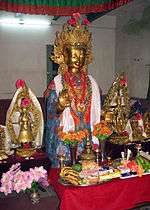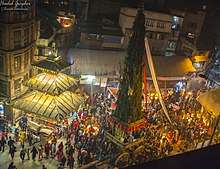Newar Buddhism
Newar Buddhism is the form of Vajrayana Buddhism practiced by the Newar people of the Kathmandu Valley, Nepal.[1][2] It has developed unique socio-religious elements, which include a non-monastic Buddhist society based on the Newar caste system and patrilineality. The ritual priests (guruju), vajracharya (who perform rituals for others) and shakya (who perform rituals mostly for their own families) form the non-celibate religious sangha while other Buddhist Newar castes like the Urāy act as patrons. Uray also patronise Tibetan Vajrayanin, Theravadin, and even Japanese clerics.[3]
| Part of a series on |
| Vajrayana Buddhism |
|---|
 |
|
Traditions Historical traditions:
New branches:
|
|
History |
|
Pursuit |
|
Practices
Fourfold division: Twofold division: Thought forms and visualisation: Yoga:
|
|
Festivals |
|
Tantric texts |
|
Ordination and transmission |



Although there was a vibrant regional tradition of Buddhism in the Kathmandu Valley during the first millennium, the transformation into a distinctive cultural and linguistic form of Buddhism appears to have taken place in the fifteenth century, at about the same time that similar regional forms of Indic Buddhism such as those of Kashmir and Indonesia were on the wane. As a result, Newar Buddhism seems to preserve some aspects of Indian Buddhism that were not preserved in schools of Buddhism elsewhere.
Artistic tradition
Newar Buddhism is characterized by its extensive and detailed rituals, a rich artistic tradition of Buddhist monuments and artwork like the chaitya (stupa), Baha and Bahi monastic courtyards, statues, paubha scroll paintings and mandala sand paintings, and by being a storehouse of ancient Sanskrit Buddhist texts, many of which are now only extant in Nepal.[4]
According to the authors of Rebuilding Buddhism: The Theravada Movement in Twentieth-Century Nepal: "Today traditional Newar Buddhism is unquestionably in retreat before Theravada Buddhism."[5] Chachā (Charyā) ritual song and dance and Gunlā Bājan music are other artistic traditions of Newar Buddhism.[6] Although Newar Buddhism was traditionally bound to the Kathmandu Valley and its environs, there is at least one new Newar Buddhist temple in Portland, Oregon.[7]
Outdoor festivals

A number of major street celebrations are held periodically involving processions, displays of Buddha images and services in the three cities of the Kathmandu Valley and in other parts of Nepal.
The main events are Samyak (almsgiving and display of Buddha images), Gunla (holy month marked by musical processions and display of Buddha images), Jana Baha Dyah Jatra (chariot procession in Kathmandu), Bunga Dyah Jatra (chariot processions in Lalitpur, Dolakha and Nala), and Bajrayogini Jatra (processions in Sankhu and Pharping).
Newar Buddhism news
Newar Buddhism is largely practiced within the community, however news about Newar Buddhist functions and festivals is reported in Nepali by the Kathmandu based TV channel, Bodhi TV.[8]
References
- Locke, John K. (2008). "Unique Features of Newar Buddhism". Nagarjuna Institute of Exact Methods. Archived from the original on 2012-03-24. Retrieved 2 June 2011.
- Novak, Charles M. (1992). "A Portrait of Buddhism in Licchavi Nepal". Buddhist Himalaya: A Journal of Nagarjuna Institute of Exact Methods. Nagarjuna Institute of Exact Methods. 4 (1, 2). Retrieved 20 March 2014.
- Yoshizaki, Kazumi (2006). "The Kathmandu Valley as a Water Pot: Abstracts of Research Papers on Newar Buddhism in Nepal". Kumamoto: Kurokami Library. Archived from the original on 2013-10-04. Retrieved 2 June 2011.
- Gutschow, Niels (November 2011). Architecture of the Newars: A History of Building Typologies and Details in Nepal. Chicago: Serindia Publications. p. 707. ISBN 978-1-932476-54-5.
- LeVine, Sarah; Gellner, David N. (2005). Rebuilding Buddhism: The Theravada Movement in Twentieth-Century Nepal. Harvard University Press. p. 37. ISBN 978-0-674-01908-9.
- Widdess, Richard. "Caryā and Cacā: Change and Continuity in Newar Buddhist Ritual Song". Asian Music. University of Texas Press. 35 (2): 7–41. JSTOR 4098444.
- Founding Ceremonies for Nritya Mandal Vihara Archived July 1, 2011, at the Wayback Machine
- बोधी संवाददाता काठमाडौं
Further reading
- Gellner, David N. (1992). Monk, Householder, and Tantric Priest: Newar Buddhism and its Hierarchy of Ritual (Cambridge Studies in Social and Cultural Anthropology). Cambridge University Press. ISBN 978-0-521-38399-8. - Review of this book Theodore Riccardi Jr.
- Lewis, Todd L. (2000). Popular Buddhist Texts from Nepal: Narratives and Rituals of Newar Buddhism (SUNY Series in Buddhist Studies). State University of New York Publications. ISBN 978-0-7914-4611-9.
- Locke, John K. Newar Buddhist Initiation Rites
- Mahajan, Phra Sujan (B.E. 2549). The Revival of Theravada Buddhism and its Contribution to Nepalese Society, Thesis, Bangkok: Mahachulalongkornrajavidyalaya University
- Tuladhar-Douglas, Will (2006). Remaking Buddhism for Medieval Nepal: The Fifteenth-century Reformation of Newar Buddhism. New York: Routledge. ISBN 978-0-415-35919-1.
- Tuladhar-Douglas, William (2002). "Newar Buddhism". Religions of the World.
External links
- Bajracharya
- The Art of Newar Buddhism, The Huntington Archive